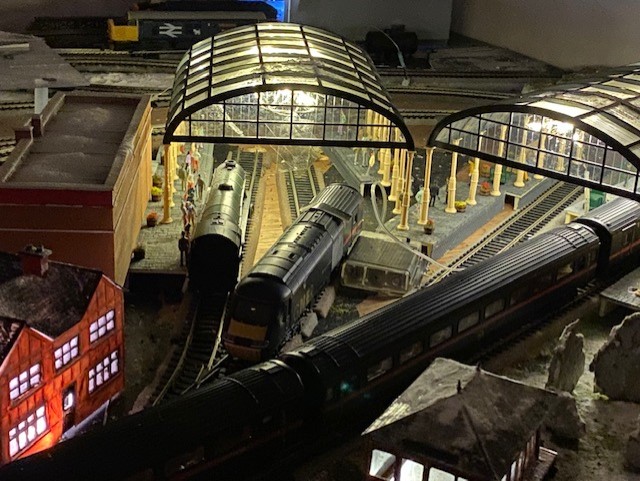I'm Still not A Modeller by Phil Cooper
by Phil Cooper
If you’ve been reading this blog from it’s birth you’ll be well aware that I am NOT a modeller. I don’t have any of the required skills that most of you have. Consequently I have to ask people to help me out. I’m lucky to have some great neighbours and my best “assistant” is next door neighbour, Timeo. This young lad is going to be very rich. He’s good at EVERYTHING.
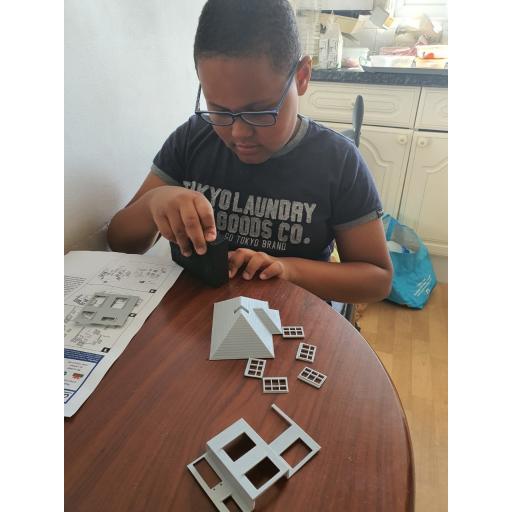
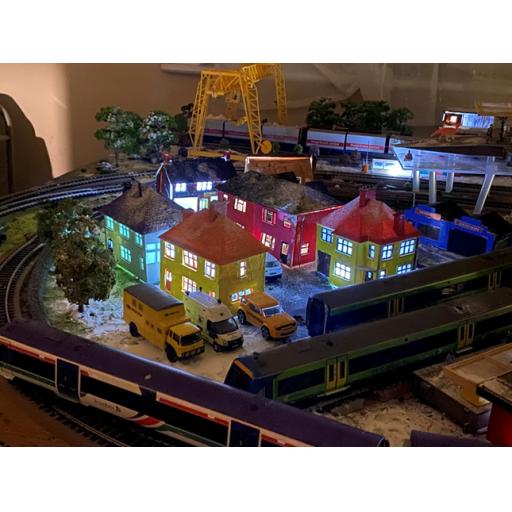
Timeo built most of these houses while I built the dark one at the top. You can see the shafts of light coming through between it’s walls. I placed the buildings on the layout and you can see the light coming through underneath. Timeo would have positioned them perfectly.
My other assistant Is Jimbo. All my friend’s names end in “o”. So there’s Barryo, Dano, Charlo, Davo, Edo, Franco (no relation), Garo, Harro, Iaino, Jacko, Keitho, Larryo, Miko, Nato, Oso, Peto, Quento, Robo, Samo, Timo, Ulysso, Vino, Xandero, Willo, Yaniko and Zako. You probably don’t believe I have so many chums!
Anyway, Jimbo was a colleague of mine when we worked in Dover Customs & Excise. He’s a great bloke and runs me around in his car as I’m not yet allowed to drive since my stroke. Ed. Comments- yes yes we know you had a stroke-move on I should also tell you he’s Irish coming from the loyalist enclave of Londonderry but for some inexplicable reason he refers to Londonderry as JustDerry. I think it’s an Irish thing!
This is Jimbo happily carrying out my instructions.
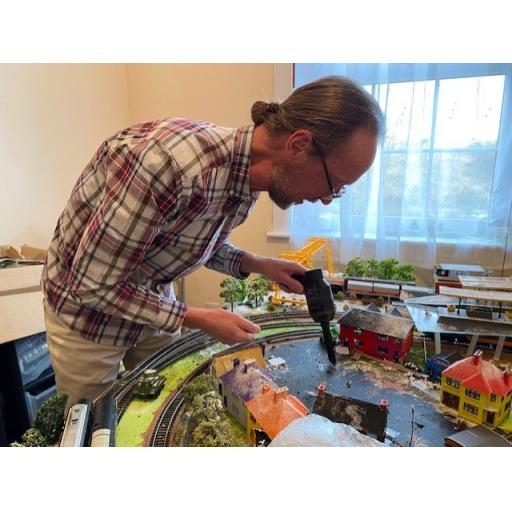
Being simple-minded he was fascinated by my mini-hoover
But sometimes he gets fed up with my clear instructions
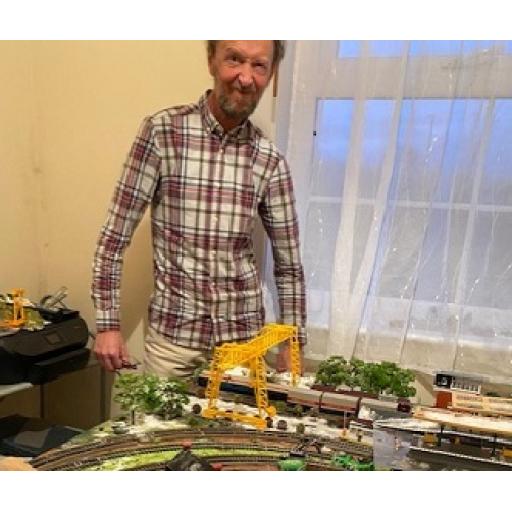
And, sometimes, as here, he can be a bit precious
Right, here we go. I was perusing the Facebook groups today and found somebody who was about to join the hobby and wanted to know what he needs to start a DCC layout. The first response was “lots of money”. That negativity surprised me. Before I began my layout I visited my local model shop, Turners Model Shop in Dover and met a guy called Peter. I mentioned DCC to him as I had never heard of it. He was very upbeat about it and took the time to explain it to me. What impressed me was that he didn’t try to make me part with my money. He was a true enthusiast and after 20 minutes I was convinced that DCC was the way to go.
So, readers speak to your local shop if you have queries. They’re probably enthusiasts too. Since meeting Peter I’ve become a regular visitor to the shop which is run by Shirley Slater and her husband Terry. They’re both great sources of information. Terry is an electrickery genius and brilliant with a soldering iron. He sometimes speaks in a language I just don’t recognise. I think he feels sorry for me as I do ask some stupid questions but he doesn’t take the “p” In fact he occasionally discounts some of his work for me. So here’s a reminder; Get to know your local model shop. Peter in the shop has also spent some time with me advising me how to build scenery which is his forte. His advice which I will pass on to you for free is – TAKE YOUR TIME.
So, 2 bits of advice for you already:
1.Get to know your local model shop
2 Take your time building scenery and models
Back to the story. After Peter told me about DCC I bought a Hornby trainset from Amazon. It was called a Mixed Train set. I chose it because it came with a DCC Select controller and 2 DCC-chipped, locomotives, a Class 08 shunter and a steam loco called a “jinty” and I was up and running. I have to admit that I felt very guilty not buying it from their shop but since then I’ve bought loads of paint, plaster cloth and track which made me feel a bit better.
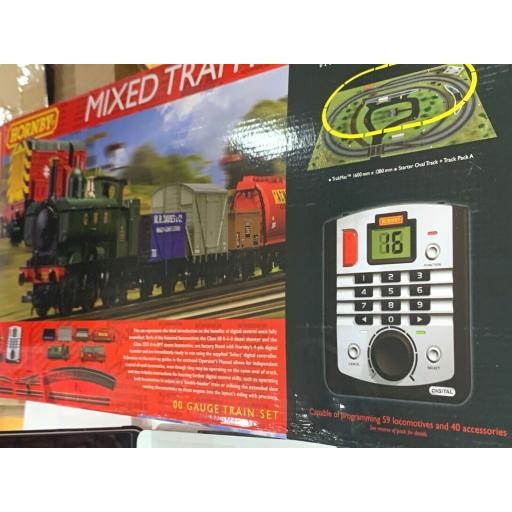
A day or so later the Hornby set (as usual packed with the remnants of 2 trees) arrived and that evening I was up well after midnight putting the track together. I started with an oval which had a set of points leading to a siding. The booklet accompanying the set gave easy instructions to set up my new locomotives. I have to admit that electrickery and me is NOT a good combination but the instructions were easy to follow; even for me. If you’ve read some of my earlier blogs you’ll knowthat if I can do something then so can you. Since my stroke; Ed comment- stroke, yes yes. Move on- which battered my memory and concentration making things even more difficult for me so I repeat, if I can do something, you can too! Trust me.
I think DCC is the future of railway modelling. I use the Hornby DCC Select to control my layout. It retails at just over £100. My controller came with the Mixed Freight set so, for me, with the two DCC locomotives it gave me a flying start. Things got even better a few hours later when I remembered my first attempt to build a layout which went badly wrong. This was the Hornby Eurostar set which I bought for Iain. He didn’t take to it and because we laid it out on the floor, I wasn’t keen. After years of playing rugby, volleyball and basketball my knees were in a bad state and it became too painful for me to kneel for even a few minutes. So the entire set went into one of the drawers under my bed! But I dug it out and placed that first Eurostar on the track. Back then my initial enthusiasm took me to a second hand shop where they had a large stock of train stuff. I recognised a locomotive from Inverness. It was a Lima Class 26. It must have been at least 30+ years since it had seen any track.
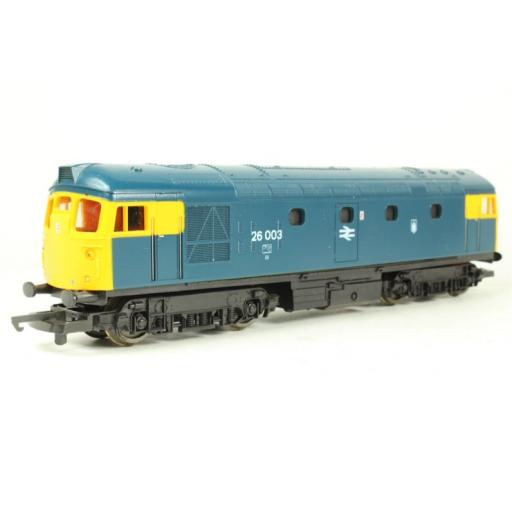
It worked first time without even a push. It roared around the track like a crazed puppy. Another welcome surprise happened when I placed that old Eurostar on the track.
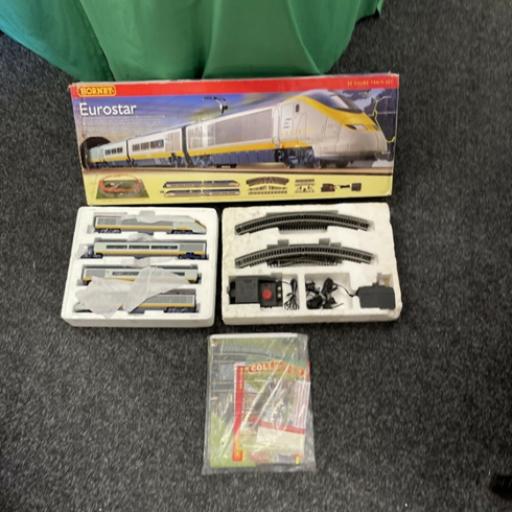
That locomotive had been in storage for well over 30 years but, once again, it sped off round the track. Now nearly 40 years later they are both still working well. In fact I regard the Class 26 as my goto when I have any track problems. It always runs well. Since then I’ve added a DCC chip to the Eurostar but, unfortunately the 26 couldn’t be chipped – too old. You won’t be surprised to learn that I don’t have the skills needed to add DCC chips to my DC locomotives. But Terry, another enthusiast but with incredible skill helped me by giving me discount on fitting DCC chips and I just had to pay £30 each to have my locos chipped and “DCC Fitted”. It was generous of him. I think he felt sorry for me when I told him that I was useless. Moments later he had a loco on his test track. This is absolutely true because I just looked at the loco he had on the track and it came to a sudden halt! So most of you probably don’t know an electronic genius like the charitable Terry but if you can master a soldering iron you can add your own chips as well as sound chips. Unfortunately I can’t even remove the roof of a loco to get into it’s guts and do the work-I’m lazy.
So a DCC-fitted loco will probably cost you about £50 more than a DC loco and having a chip fitted to a DC loco will be a similar cost. I just mentioned sound. I love using sound-equipped locos. My very favourite loco is the Class37 and when you hear it thundering round the track you’ll want it too. But it’s expensive. You’re looking at a price of at least £100 for a good sound chip and more for fitting. So, here again, it’s better (cheaper)if you can do it yourself.
DCC stands for Digital Command Control.
Time for a quick history lesson from Wikipedia.
A digital command control system was developed (under contract by Lenz Elektronik GmbH of Germany) in the 1980s for two German model railway manufacturers, Märklin and Arnold. The first digital decoders that Lenz produced appeared on the market early 1989 for Arnold (N) and mid 1990 for Märklin (Z, H0 and 1; Digital=). Märklin and Arnold exited the agreement over patent issues, but Lenz continued to develop the system. In 1992 Stan Ames, who later chaired the NMRA/DCC Working Group, investigated the Märklin/Lenz system as possible candidate for the NMRA/DCC standards. When the NMRA Command Control committee requested submissions from manufacturers for its proposed command control standard in the 1990s, Märklin and Keller Engineering submitted their systems for evaluation. The committee was impressed by the Märklin/Lenz system and had settled on digital early in the process. The NMRA eventually developed their own protocol based on the Lenz system and further extended it. The system was later named Digital Command Control. The first commercial systems built on the NMRA DCC were demonstrated at the 1993 NMRA Convention, when the proposed DCC Standard was announced.
Sorry about all the initials. So what can you do with DCC that you can’t do with DC? Lots.
For instance a company I’ve mentioned before, Train-Tech sell light signals which can be controlled by your DCC controller. I can set them up so it’s obviously easy. In fact, it’s simple and the signals look great. They offer a full range of signals including Feather, Theatre and even small Ground signals just like the real thing. I’ve said before that small details really “make” a layout. Signals do that. You can link signals so that as the train is about to enter a block (technical term) the signal is green. The signal turns automatically red while the train is in the block. By linking the signals you will see the signals turning red and green in turn. It’s fascinating.
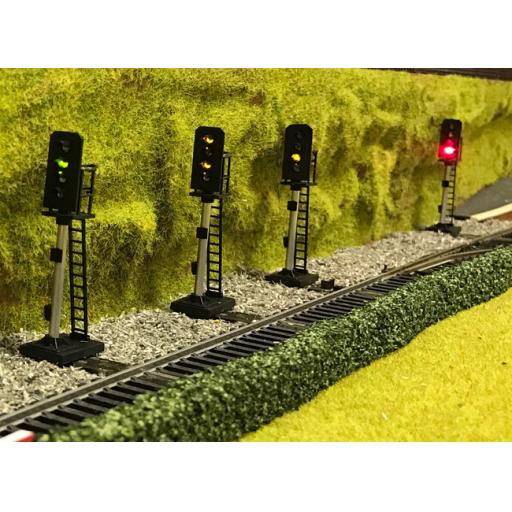
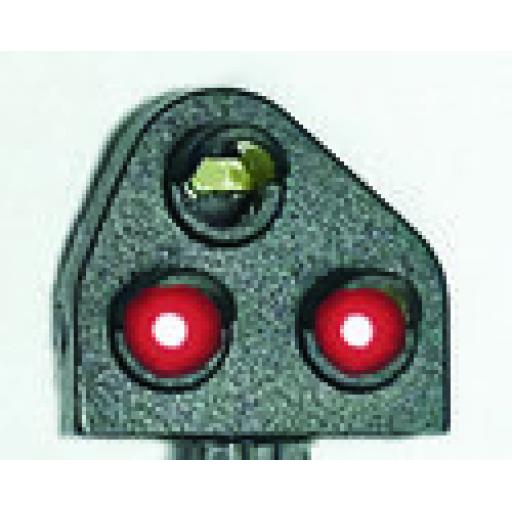
Train-Tech Signals
Train-tech also offer a fully automated level crossing with flashing lights and sound again controlled by your DCC controller. Their double crossing costs £45.
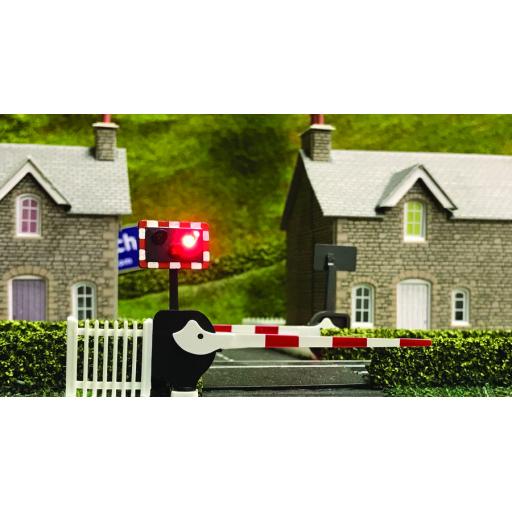
Points, too, can be controlled by the controller. I have great difficulty walking (post-stroke effects) ;Ed comment - Give me strength-and it is a great help to be able to control the points on the far side of my board. My grandson, Harrison, loves watching all these elements come alive.
All that is just for starters. Currently we (my 2 grandsons, Harrison and Nate) own 20 DCC locos including the Virgin Pendolino, Flying Scotsman, GWR Class 802, Class 68,Class 08 shunters and Eurostar and, of course my sound-fitted Class37s. We have 25 DC locos including some Class43. Class47 and Class 37. Back when I was starting out I wanted to run both, DC, and DCC locos but couldn’t put them on the same layout. My son, Iain, had a bright idea. It was simplicity itself. I have 2 ovals of track, 1 inside the other. He suggested I use the inner oval under DC control and the outer oval under DCC as a sort of high speed line so it has the Pendolino and Eurostar types roaring around it. Crucially there is no connection between the ovals but off the inner oval I have points leading to a 4 road terminal (Harrison City) and a branch line (Danidza Junction – my niece in Australia). My Eurostar is named after her -Danidza Cooper.
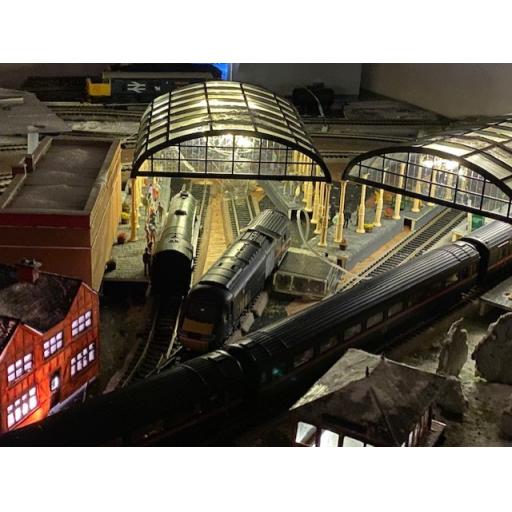
Harrison City Terminal (I used LED chains as lighting-I think they work well
I’ve just extended my board giving it a width now of 5’5” which houses a container terminal, a TMD and a fuel point.
Using DCC I am able to place several trains at various points on the layout. For instance I have 3 of my Class 37s waiting at the TMD and fuel point and a Class68 and 67 sitting in the containerport and on the outer oval I’ve got the GWR Class802. Under DCC each of these locomotives has a unique control number. For instance the Class 68 has the control number 5, The 37s have, 6,7 and 8 and the 802 has 5. By the way it’s easy to programme the numbers for each locomotive into the controller – I’m talking 10 seconds for each locomotive! Yes, it’s that simple.
Now I can bring each loco to life by selecting each loco’s number and then I can move it. While that’s happening I can open up the 802 by selecting it’s number and off he goes. So, both are moving independently in various locations and directions. If I wanted I could run 2 DCC locos on the outer oval being careful to have them moving in the same direction and watching their speeds. I used this to put my Flying Scotsman on the track and taking a video of it from another locomotive travelling at a similar speed in front of 4472. It looks great. Now kids, be careful if you are using a number of locomotives at the same time. My next little DCC project is to “choreograph” a video of the locos moving about in the containerport and TMD-great fun.
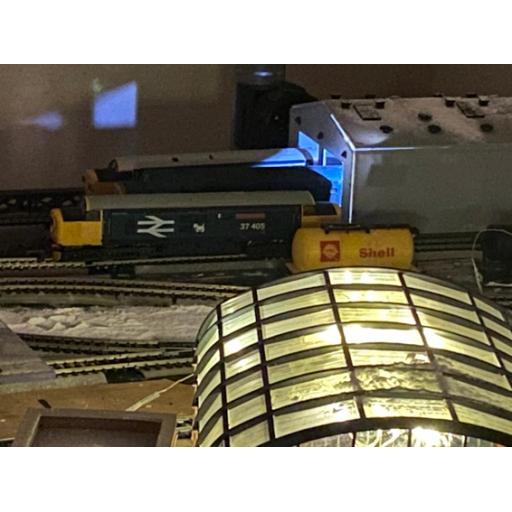
So there you go, I love DCC and can’t understand why some people don’t like it or are frightened by it.. Yes it is a bit more expensive but there are some good deals out there. For instance on eBay this evening they have a Hornby A3 steam locomotive with sound, current bid, £75, a Hornby GBRf Class 66 current bid £75, a brand new Vitrains Class47 with sound currently bidding at £170. (See my blog, “eBay is it worth it?”) I’ve bought quite a few Vitrains locos. They’ve all been very good, even second hand. I’ve used eBay to buy quite a few locos. I’ve found locos from Vitrains, Heljan and Bachmann give better value than Hornby. Just saying!
eBay leads us into a different topic. I’ve found an eBay seller with morals. He is Andy. Andy had a GNER Highland Chieftain for sale. But he told me he wouldn’t offer any refunds which thought was unfair. Andy sent me a response and here it is:
My listing description clearly states the item is untested and my standard policy, as is the same with almost every other eBay seller, is no returns accepted. This is also clearly stated on the listing.
I buy things at auction almost every day and 99.9% of the time no guarantees are given as to whether they work?
What you may not know is this if I offered refunds. I sell you the set and due to its value, I pay £16 for special delivery postage (to provide suitable insurance in case of loss or damage), far more than I’ve charged you. You then decide you don’t want it and request a refund, which may or may not be justified. I am then not only expected to provide a full refund including postage, but also provide another £16 for return secure postage. I’m therefore over £20 down, which negates most, if not all of the profit I can make selling the item.
I take pride in being transparent and honest in my dealings.
I thought that was a reasonable stance. So reasonable that I will bid for it if the price stays within the range of my wallet.
Bye for now
If you would like to read more blog posts from Phil check back every two weeks or sign up to our newsletter to keep up to date on site news or when the blog posts go live.
The views and opinions expressed within the content are solely the author's and do not reflect the opinions and beliefs of Trackside Signs or its affiliates.






